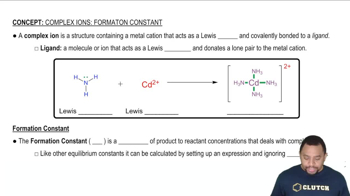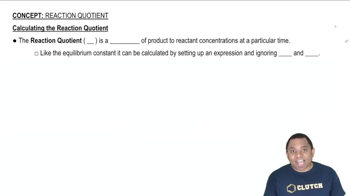Here are the essential concepts you must grasp in order to answer the question correctly.
Solubility Product Constant (Ksp)
The solubility product constant (Ksp) is an equilibrium constant that applies to the solubility of sparingly soluble ionic compounds. It is defined as the product of the molar concentrations of the ions, each raised to the power of their coefficients in the balanced equation. For AgI, Ksp can be used to determine its molar solubility in water by setting up the equilibrium expression based on its dissociation into Ag⁺ and I⁻ ions.
Recommended video:
Solubility Product Constant
Formation Constant (Kf)
The formation constant (Kf) quantifies the stability of a complex ion in solution, representing the equilibrium between the complex and its constituent ions. For the complex ion [Ag(CN)2]⁻, Kf indicates how readily Ag⁺ ions react with CN⁻ ions to form the complex. This value is crucial for calculating the equilibrium constant for the reaction involving AgI and CN⁻, as it reflects the extent to which the complex forms in solution.
Recommended video:
Complex Ions and Formation Constant
Equilibrium Constants and Reaction Quotients
Equilibrium constants (K) relate the concentrations of products and reactants at equilibrium for a given reaction. The reaction quotient (Q) is similar but can be calculated at any point in the reaction. By using Ksp and Kf, one can derive the equilibrium constant for the reaction involving AgI and CN⁻, allowing for the determination of how the presence of CN⁻ affects the solubility of AgI in solution.
Recommended video:
 Verified step by step guidance
Verified step by step guidance

